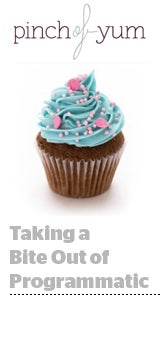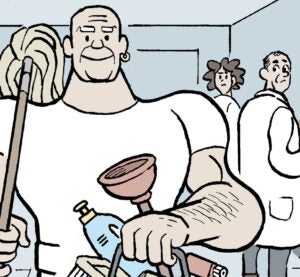 Professional food bloggers have long relied on ad networks to monetize their audience.
Professional food bloggers have long relied on ad networks to monetize their audience.
A few million page views or more can be enough to earn a living. But these long-tail content creators are also feeling the effects of programmatic, viewability and the shift to mobile.
One example: Food blog Pinch of Yum, run by a husband-and-wife team, earned $25,000 last month, with a $10.83 RPM (the combined CPM from all the ads on a page).
A good chunk of that revenue came from its three primary ad partners: Sovrn, which brought in $5,597, Conde Nast’s Food Innovation Group, which contributed $2,393, and Gourmet Ads at the bottom of the stack, which added $1,369. There’s also Yellow Hammer, which added $5,651.
The setup is familiar to publishers of all sizes.
“We have a rough waterfall set up, with the higher CPM network first, and we trickle down until we have a 100% fill rate at the bottom,” explained Bjork Ostrom, who runs the business side of Pinch of Yum.
As programmatic rises, the biggest impact Ostrom sees is a lack of control over ad quality.
“The filtering technology has yet to catch up,” he said. “We’re constantly having to monitor ads that are playing with audio or really poor-quality ads. We don’t mind autoplay video, but if it’s autoplay audio, that gets a little invasive and annoying and we think that will turn people off really quick.”
In the ad network days, campaigns had to be approved before they ran, increasing quality. But with the advent of real-time bidding, bloggers like Pinch of Yum lost control over who appears on the site.
Ostrom is also thinking about viewability: “We’re seeing the importance of viewability and how that can impact programmatic and people buying ads.”
He’s especially concerned with increasing viewability on mobile, an area of low performance. “Our site is 60% mobile, and we’re doing a poor job of monetizing that,” Ostrom said.
Pinch of Yum plans to move from a mobile-optimized site to a mobile-templated site in the next few months to improve ad viewability.
“With traditional mobile-responsive sites, [sidebar ads] would get pushed down to the bottom, so you wouldn’t have viewability or impressions,” Ostrom said. With mobile templating, which creates a unique layout just for mobile, “you’ll have more impressions and viewability and better ads. It has the potential to be a poor user experience in that they’re seeing more ads, but for us it just has to happen.”
Pinch of Yum wants to improve the mobile experience partially to capitalize on Pinterest. “Pinterest mobile is such a big traffic driver for us, so if we’re able to have those ad impressions count that will be a huge win for us,” Ostrom said.
Blogger Sally McKenney of Sally’s Baking Addiction has seen Pinterest rise to her second-highest source of referrals next to Facebook. “Pinterest is more permanent,” McKenney said. “Something I pinned a year ago can come up.”
While bloggers like Sally and Bjork know they need to be smart about advertising, they keep the focus on content creation first.
McKenney earns the majority of her revenue from advertising, but leaves most of the management and optimization to her primary ad partner, Sovrn, where she has a dedicated rep.
“I’ve worked with so many ad networks in the past, and I’ve left them because I don’t feel comfortable with the amount of support I get,” she said.
She checks in weekly via Sovrn’s interface, Meridian, which will show the usual details like CPM and fill rates along with more unique ones. She can break down CPM by category to see if she gets higher CPMs from health and fitness posts, for example. She can also compare her clearing prices to those of her peers, offering her more transparency into her performance.
The dashboard gives her just enough oversight to turn her focus back to content. “I don’t have time to understand the infrastructure, I’m just concerned with having the content on my blog be successful,” McKenney said.
Even Ostrom, a sophisticated blogger who offers eBooks and training to other food bloggers, recognizes that advertising could be better handled by someone else. He recommends that bloggers understand things like ad networks generally, but keep their focus on content creation, “because without the content, no one is going to come.”
He plans to decrease his focus on managing the advertising side in the future, following his own advice.
“We’re going to start to outsource it,” Ostrom said. “Right now it’s really about putting out fires, it’s not proactive.”
The blog plans to work with AdThrive, which will integrate Pinch of Yum’s current ad networks into DFP and manage it. It charges not on a percentage of revenue, but for the rights to one below-the-fold banner ad placement.
While programmatic is challenging publishers, it’s also hands-off, fitting with the needs of bloggers who need to focus their attention on scaling their blog, not squeezing dollars from it.
“I’m really interested in the direct sales stuff, but I think it makes less and less sense with the rise of programmatic,” Ostrom said. “Because of the reality of where we see the industry headed and our limited bandwidth, it doesn’t make a ton of sense to be focusing on direct sales.”












